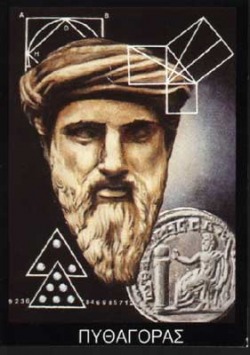Pythagoras, the myth, the legend

Born in the sixth century B.C. on the island of Samos, near the coast of modern day Turkey, Pythagoras is well-known today for his immense contributions to mathematics, music, and philosophy (Maor, 2007, p. 17). As a child, he traveled extensively with his father Mnesarchus for business. This gave him exposure to the knowledge of multiple peoples such as the Chaldaeans, the Italians, and the Egyptians (O’Connell & Robertson, 1999).
Interestingly, multiple scholars question the details of Pythagoras’ upbringing and influences. According to Maor (2007), “Pythagoras is one of the most mysterious figures in history; the little we do know about him may be more fiction than fact (p. 17). Regardless of validity, Pythagoras is one of the most infamous mathematicians to date. Valens (1964) writes in his book which examines Pythagoras’ work that, “…there is no doubt that his [Pythagoras’] reckoning with squares, gnomons, and right-angled triangles proved to be immortal (26).
During Pythagoras’ life in the late 500s, he explored not only mathematics, but music and religion. It is documented that Pythagoras spent a considerable amount of his career studying with famous Grecian philosopher, Thales (Maor, 2007, p. 18). The young scholar traveled to key cities of civilization such as Egypt and Persia to learn their philosophies and question their beliefs (O’Connell & Robertson, 1999). This would greatly influence the foundational beliefs of the society Pythagoras created later on in Italy. Prior to settling in Italy with the Pythagoreans, Pythagoras founded a school in Samos called the semicircle (O’Connell & Robertson, 1999). Iamblichus writes in the third century A.D.
“... he formed a school in the city [of Samos], the 'semicircle' of Pythagoras, which is known by that name even today, in which the Samians hold political meetings. They do this because they think one should discuss questions about goodness, justice and expediency in this place which was founded by the man who made all these subjects his business. Outside the city he made a cave the private site of his own philosophical teaching, spending most of the night and daytime there and doing research into the uses of mathematics... (O’Connell & Robertson, 1999) ”
Around 530 B.C. Pythagoras relocated to Italy to form his Pythagorean Society and remained there for twenty years. “The Pythagoreans, also known as mathematikoi, taught that the purpose of life was to purify the soul and body (Pythagoras, 2010) ( O’Connell & Robertson, 1999). The greatest scientific contribution of the Order was the musical scale and the harmonies that existed within it. Discovering acoustics naturally paralleled mathematical practice. During Pythagoras’ time in history, music, particularly music played on a lyre, was as important as arithmetic and philosophy (Maor, 2007, p. 20).
To date, Pythagoras is most well-known for and credited with the discovery of the right triangle theorem titled for his namesake --- the Pythagorean Theorem. Ironically, this mathematical principle traces back over 1000 years before Pythagoras’ era to the Babylonians, yet historians claim that Pythagoras was the first to prove the theorem (O'Connor, J, & Robertson, 1999). Nothing is recorded in reference to his death or later years, but Pythagoras lived well into his sixties (Pythagoras, 2010).
Interestingly, multiple scholars question the details of Pythagoras’ upbringing and influences. According to Maor (2007), “Pythagoras is one of the most mysterious figures in history; the little we do know about him may be more fiction than fact (p. 17). Regardless of validity, Pythagoras is one of the most infamous mathematicians to date. Valens (1964) writes in his book which examines Pythagoras’ work that, “…there is no doubt that his [Pythagoras’] reckoning with squares, gnomons, and right-angled triangles proved to be immortal (26).
During Pythagoras’ life in the late 500s, he explored not only mathematics, but music and religion. It is documented that Pythagoras spent a considerable amount of his career studying with famous Grecian philosopher, Thales (Maor, 2007, p. 18). The young scholar traveled to key cities of civilization such as Egypt and Persia to learn their philosophies and question their beliefs (O’Connell & Robertson, 1999). This would greatly influence the foundational beliefs of the society Pythagoras created later on in Italy. Prior to settling in Italy with the Pythagoreans, Pythagoras founded a school in Samos called the semicircle (O’Connell & Robertson, 1999). Iamblichus writes in the third century A.D.
“... he formed a school in the city [of Samos], the 'semicircle' of Pythagoras, which is known by that name even today, in which the Samians hold political meetings. They do this because they think one should discuss questions about goodness, justice and expediency in this place which was founded by the man who made all these subjects his business. Outside the city he made a cave the private site of his own philosophical teaching, spending most of the night and daytime there and doing research into the uses of mathematics... (O’Connell & Robertson, 1999) ”
Around 530 B.C. Pythagoras relocated to Italy to form his Pythagorean Society and remained there for twenty years. “The Pythagoreans, also known as mathematikoi, taught that the purpose of life was to purify the soul and body (Pythagoras, 2010) ( O’Connell & Robertson, 1999). The greatest scientific contribution of the Order was the musical scale and the harmonies that existed within it. Discovering acoustics naturally paralleled mathematical practice. During Pythagoras’ time in history, music, particularly music played on a lyre, was as important as arithmetic and philosophy (Maor, 2007, p. 20).
To date, Pythagoras is most well-known for and credited with the discovery of the right triangle theorem titled for his namesake --- the Pythagorean Theorem. Ironically, this mathematical principle traces back over 1000 years before Pythagoras’ era to the Babylonians, yet historians claim that Pythagoras was the first to prove the theorem (O'Connor, J, & Robertson, 1999). Nothing is recorded in reference to his death or later years, but Pythagoras lived well into his sixties (Pythagoras, 2010).
| lyre_music_thept.weebly.com.mp3 |
